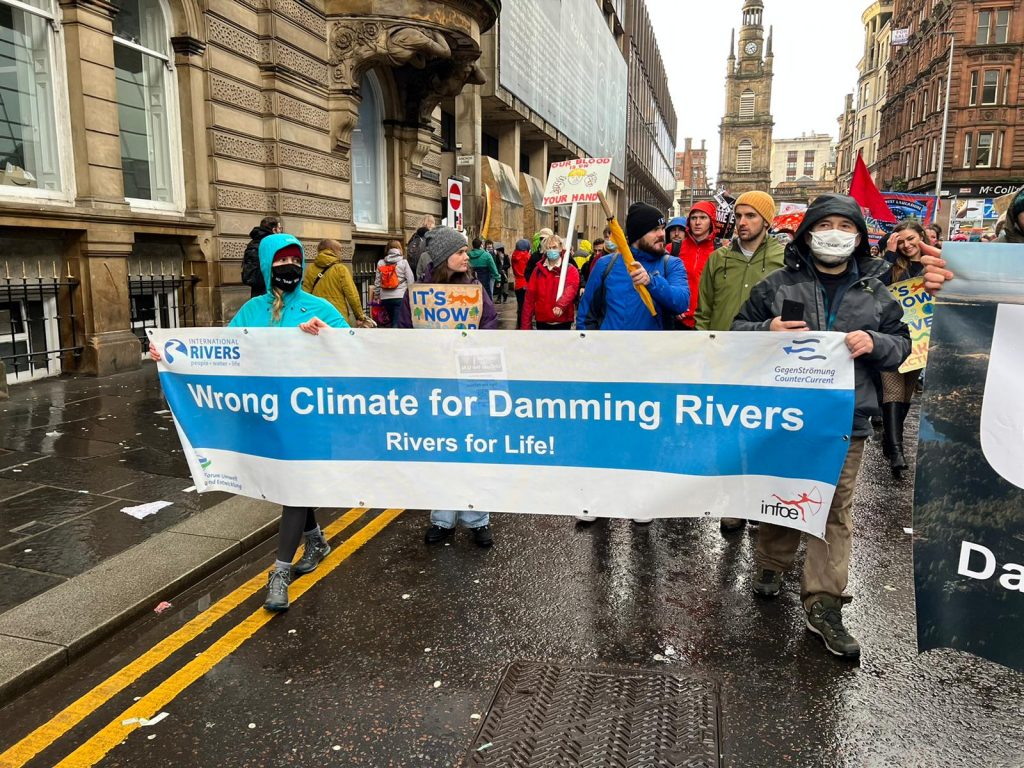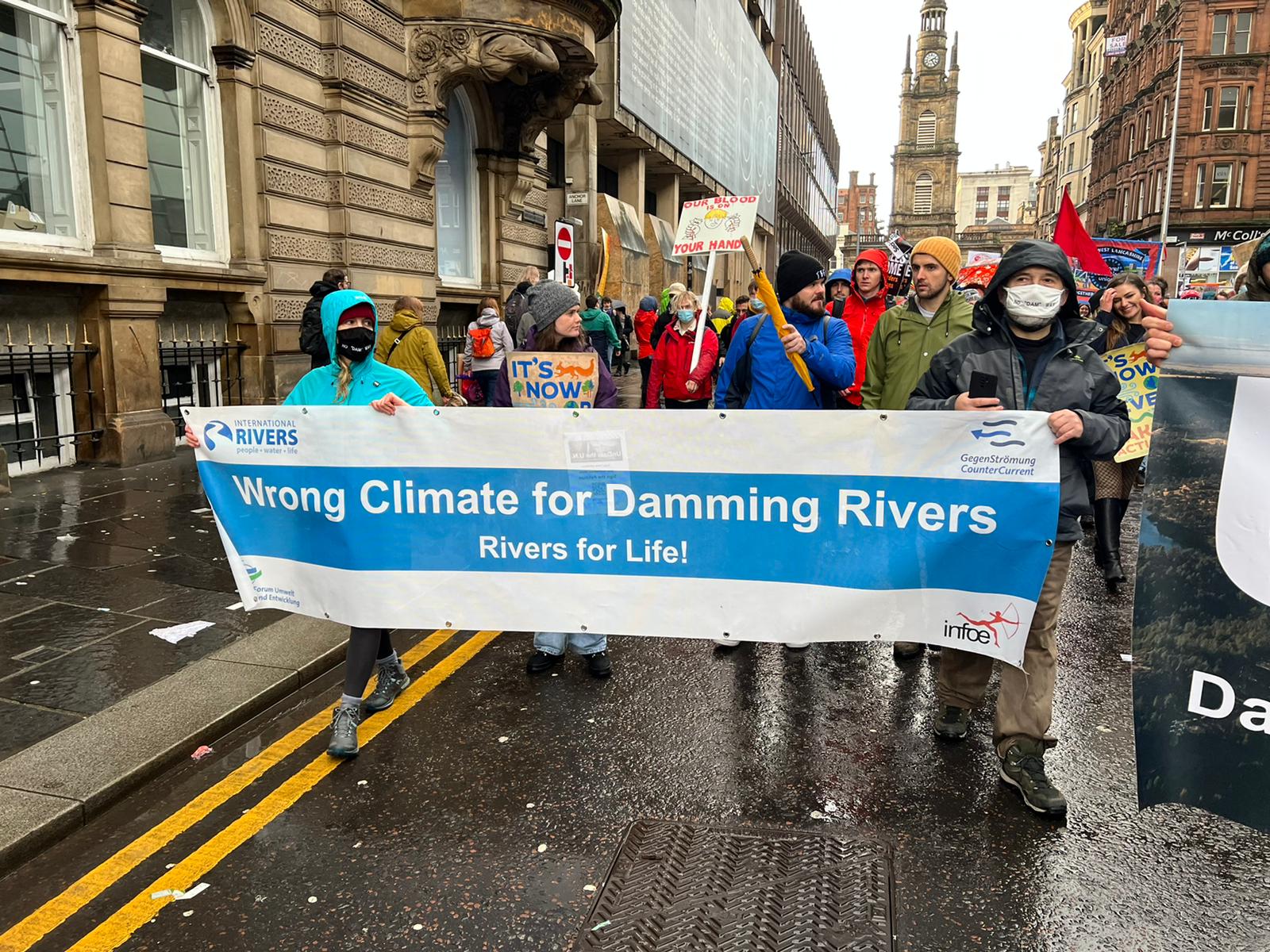
Sara Sax. Interview. High Country News
Indigenous activists and allies are highlighting how dams harm the climate and Indigenous peoples worldwide.
For two weeks, leaders and representatives from around the world have gathered in person and virtually in Glasgow, Scotland, for the United Nations’ 26th annual climate change summit, called the Conference of the Parties, or COP26. Six years ago, at COP21, nearly 200 countries signed the Paris Agreement, a groundbreaking pledge that strives to limit global temperatures to 2.7 Fahrenheit (1.5 degrees Celsius) of warming. This year, one of the things up for discussion is whether hydropower can be a solution to combat climate change.
On Tuesday, over 300 organizations from 78 countries delivered a declaration at COP26 renouncing that idea. The statement demanded that the U.N. reject the inclusion of hydropower in carbon offset schemes and bar financing of new projects using climate funds. Dams reduce biodiversity and disrupt rivers’ ability to sequester carbon, and their reservoirs release an estimated 1 billion tons of greenhouse gases globally per year due to decomposing vegetation. Scientists have shown that some dam reservoirs can emit more greenhouse gases than coal-fired power plants.
“Funding hydroelectric power construction would not only fail to prevent catastrophic climate change, it would also worsen the climate crisis by exploding methane emissions and diverting scarce climate funds away from meaningful energy and water solutions in a world that is already grappling with severe impacts of climate change,” the statement said.
It comes after a joint statement by four U.N. special rapporteurs, independent human rights experts, calling out the unaddressed and severe impacts of dams, particularly on Indigenous peoples.
High Country News talked with three leaders from the organization Ríos to Rivers about the dangers of presenting dams as a climate solution, and their takeaways from attending COP26. Founded in 2012, Ríos to Rivers connects young people from rural and Indigenous communities that are threatened by or recovering from reservoir and dam development. We spoke with Paul Wilson, a Klamath tribal member from the Klamath River Basin on the border between Oregon and California, as well as Fernanda Purrán, of the Mapuche Indigenous people, and Paula Riffo, both from the Biobío River Basin in Chile.
The Klamath supports endangered salmon and other fish. The Biobío, Chile’s second-largest river, is a crucial source of drinking water. Both rivers hold immense importance for the Indigenous peoples that live along their banks, and both have been severely impacted by hydroelectric dams.
This conversation has been edited for length and clarity.
High Country News: Tell us why you are at COP26 this year. What are you advocating for?
Paul Wilson: I am at COP this year with the delegation “Rivers for Climate,” demanding that the United Nations stop recognizing dams as clean energy. Currently, dams are being funded as “clean energy” through mechanisms like the Clean Development Mechanism under the United Nations and through carbon offset trading programs. They have not recognized the methane emissions that come out of the reservoirs behind dams, (a gas) that is 86 times more impactful than CO2 in the short term.
These false solutions continue to deter us from making meaningful change within the climate crisis, as well as continue to disenfranchise and (commit) genocide (against) Indigenous people. I’m also advocating for other Indigenous communities that are being forced to bear the brunt of developing energy projects like this.
Fernanda Purrán: I am from the Mapuche peoples in Chile and live in the Biobío River Basin. Since the ’90s, hydroelectric plants have been built on the Biobío River. The first two had strong opposition among the Mapuche but also nationally — it’s one of the largest extractive projects in Indigenous territories in Chile. The National Human Rights Commission made an agreement with the communities that they were never going to build dams in the Biobío again; however, a third was built, and now they want to build a fourth. We have been enduring the damage and ecocide for more than 24 years, and the suffering that our communities and our culture have experienced. They have taken away our right to be a free people, to be an Indigenous people, with the ability to live our worldview and our culture freely.
Paula Riffo: I live in the Biobío River Basin , a little further down from where Fernanda lives. I am the spokesperson for a movement that is against the construction of the fourth hydro dam on the Biobío river. The three power plants that are upstream from my house affect me directly. In my town, the sudden rise in the flow of the river, a product of the hydroelectric plants, has killed fishermen. The power plants generate ecological and social damage in the territories. It’s connected to the COP because here they call that clean energy. We believe that we must bring the voice of the territories here. If we don’t bring the problem here, how are they going to listen to it?
These false solutions continue to deter us from making meaningful change within the climate crisis, as well as continue to disenfranchise and (commit) genocide (against) Indigenous people.
HCN: What at COP26 are you most paying attention to?
PW: The lack of representation within Article Six under the United Nations of Free Prior and Informed consent for Indigenous peoples. (Editor’s note: Article Six of the Paris Agreement essentially establishes an international carbon market so that high-emitting countries can trade emissions to reach their climate goals; it is one of the most contentious parts of the agreement.)
We are the ones that are governing and stewarding over 80% of the biodiversity left in this world. And yet you don’t see us in those meaningful spaces, creating and affecting official climate policy. To me, it is ludicrous that we continue to create policies like Article Six and the carbon offsets markets that only accommodate corporate polluters, and countries that continue to have strong relations with the corporate polluters, instead of the people that they are supposed to be representing.
HCN: Can you describe the conference? How does it work, and how are you participating?
PW: Basically, there’s two zones that exist for every single one of these COPs. There’s a Blue Zone (for national delegations), where you have to be a credentialed observer, and you have to apply for those credentials months or years ahead of time. A lot of frontline Indigenous communities don’t have that accessibility or that privilege of being recognized by the United Nations. Even within the Green Zone (the area where the general public are allowed), it also takes a lot of money, time, logistics and privilege to be able to show up.

Our day tomorrow starts probably at 6 or 7 a.m. because it takes an hour to get through security and through COVID testing. There are multiple layers of security. And then once you get in there, you have to actually walk through the hundreds of thousands of people to get to the space that you’re going to.
PR: Our participation in the Blue Zone is as observers only, trying to see the program and see if there is something important that affects our cause. Unfortunately, we don’t have a space of our own where we can talk inside there, and I think these are things that in the future we want to achieve.
FP: You see a lot of people who are not affected by the problems deciding what is going to happen. We can’t pretend it’s OK that the same people with power that have been partially responsible for the destruction of our systems are deciding how to save our planet.
PW: The Blue Zone kind of feels performative. It doesn’t seem that the actions of the world leaders track with actions that reflect the objectives (of) reducing emissions or getting us closer to any kind of climate strategy or adaptation. Continuously we see Indigenous peoples disenfranchised. And yet we are being forced to bear the brunt of these climate crises and these supposed false solutions, and still being asked how do we adapt our systems to go forward because humanity needs to stay on this planet. And so, it feels performative.
Being here means feeling some hope that in the future we can have some positive results within all this work that we do. But it also reminds us not to lower our fists and that the territorial struggles must continue.
FP: When we got here, they invited us to another event that is the COP26 Coalition (a grassroots coalition mobilizing around climate justice), and there we were able to talk about our territory and how we are solving our problems related to climate change. It was a really productive and pleasant space.
HCN: What are your takeaways?
FP: The way this event is unfolding is unfortunate, but I think it also helps us a lot to realize that we have to maintain the struggles that we have in our territories, we have to strengthen them. Being here means feeling some hope that in the future we can have some positive results within all this work that we do. But it also reminds us not to lower our fists and that the territorial struggles must continue.
PW: It is forever inspiring to see the other Indigenous youth that show up in these places that have also spent their lives doing the same work. Yet it’s also very disheartening to see that very same image and know that these other tribal Indigenous youths are spending their lives, risking life for the causes that these politicians say that they’re here for. We’re just trying to do what our natural systems (do), and what we’ve done for tens of thousands of years, and are hoping to continue (to do) with the rest of the world.
Source: https://www.hcn.org/articles/north-climate-change-bringing-the-fight-against-dams-to-cop26

